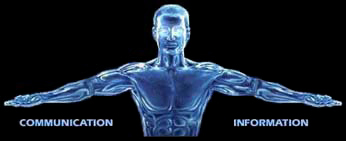Introduction
We encourage you to verify the source images for yourself, rather than just simply accept the facts that are presented here.
Exact details of the used image templates can be found here.
Some reports on this website are based on previous ones. So it is extremely important to read the reports in chronological order.
Details can turn up that were probably already been analyzed in detail. If you are new here and you directly start reading the
recent reports without prior knowledge, then it could happen, that the required context is not recognizable.
You do yourself and us a favor when you first start with the oldest reports.
This report contains references to structural anomalies in Aram Chaos. We recommend that you first review the previous reports from this series,
if you have not read them yet.
These include the following documents:
Explanatory Notes
This report deals with the breakdown of the details we were able to reconstruct on the Mars images so far.
It's not about the recognition and reconstruction of structures and shapes on Mars images, but rather to understand
in which historical context these discoveries stand. The processing of this material represents a new stage in the
project analysis and is therefore color marked in red.
A connection between the Mars symbol and the so-called winged sun disk was made in the previous report. The winged
sun disk represents an ancient religious symbol of our cultural history that is especially in
ancient Egypt and Mesopotamia, and in the Levantine culture known as an icon. The depiction is also present in several
variations in the Mesoamerican culture. This also applies to large parts of Asia, in which the Hindu religion had an
obviously strong influence to the displayed symbolism.
Besides the Mars symbol another enigmatic structure was identified, whose shape can be best compared to the mythological
figure of a dragon. The dragon-like figure is part of a survey which, due to a
partially collapsed central part, was provided, at a high probability, with larger inner chambers. Such an elaborately
decorated construction is, according to human ideas, rather less linked to technical aspects, but rather with
cultic-religious circumstances.

Reconstruction of a dragon head
Moreover, along the mentioned elevation there are still other structures, which show that there are more head-like shaped structures.
They are most likely to be compared to
snake heads.

Reconstruction of the snake heads
Some evidences suggest that the individual head structures may be part of a larger monument.
A monument that may represent a seven-headed snake creature.

Indications for a seven-headed snake creature
In the previously conducted research, parallels between the discoveries of Mars and the cultures here on Earth, have been shown.
The approach to integrate our own cultural history enabled us to provide many interesting hypotheses.
Consequently, this approach should also be maintained concerning the multi-headed dragons or serpent beings.
The theme is rather complex. The summaries of the myths and their presentation in this report may seem quite comprehensive,
in fact they represent only a very small portion of the existing dragon myths.
The Significance of the Dragon
Stories and illustrations about dragons creatures
 are known in many cultures and many eras. This is not a phenomenon that is just focused on a particular area or limited to
a few countries and cultures, but one that appears globally. It is interesting that in ancient records, dragon figures
have physical attributes, that are very often assigned to snakes. In general, hybrids seem to be a characteristic feature of the representation of ancient dragons. Today's depiction of dragons is now influenced much more by movies and computer games and has been partially detached from
ancient depictions.
are known in many cultures and many eras. This is not a phenomenon that is just focused on a particular area or limited to
a few countries and cultures, but one that appears globally. It is interesting that in ancient records, dragon figures
have physical attributes, that are very often assigned to snakes. In general, hybrids seem to be a characteristic feature of the representation of ancient dragons. Today's depiction of dragons is now influenced much more by movies and computer games and has been partially detached from
ancient depictions.
Marduk and Tiamat
The oldest records of dragons come from the Enuma Elish
 .
In the Babylonian creation myth, which was heavily influenced by Sumerian traditions, Tiamat is the Goddess of the primeval ocean/universe
in the time of chaos. Iconographically, Tiamat is depicted as a giant dragon. Tiamat, in the shape of the chaos dragon, has been killed by
Marduk .
In the Babylonian creation myth, which was heavily influenced by Sumerian traditions, Tiamat is the Goddess of the primeval ocean/universe
in the time of chaos. Iconographically, Tiamat is depicted as a giant dragon. Tiamat, in the shape of the chaos dragon, has been killed by
Marduk  and cut in two halves. As a result, heaven and earth were formed. Marduk is also often depicted with his service animal, the serpent-dragon Mushussu
and cut in two halves. As a result, heaven and earth were formed. Marduk is also often depicted with his service animal, the serpent-dragon Mushussu

Nüwa and Fuxi
In the Chinese mythology
 dragons are, like almost nowhere else in the world, firmly rooted within the culture. The oldest
known representations of dragons creatures so far come from China. Especially in the context of the Chinese emperor dragon are part of
ornaments on a large variety of furnitures, vases, other art objects, as well as on clothes.
The dragon is one of the most powerful and divine creature in China. It has to be emphasized that dragons
are supposed to rule over the water. Again, a surprising coincidence that is almost without exception part in all Mytholgies
which include the element of the dragon.
The myth of the divine couple Nüwa and Fuxi
dragons are, like almost nowhere else in the world, firmly rooted within the culture. The oldest
known representations of dragons creatures so far come from China. Especially in the context of the Chinese emperor dragon are part of
ornaments on a large variety of furnitures, vases, other art objects, as well as on clothes.
The dragon is one of the most powerful and divine creature in China. It has to be emphasized that dragons
are supposed to rule over the water. Again, a surprising coincidence that is almost without exception part in all Mytholgies
which include the element of the dragon.
The myth of the divine couple Nüwa and Fuxi
 is also connected with the emergence of mankind, which was formed by them by clay.
Both are described as beings of half-human and half snake-like shape. That's why the Chinese like to use the
term "the descendants of the dragon" for their ethnic identity. In this case, dragons are connected with positive aspects.
But in connection with divine power, they always carry the unpredictable and destructive aspect with them.
is also connected with the emergence of mankind, which was formed by them by clay.
Both are described as beings of half-human and half snake-like shape. That's why the Chinese like to use the
term "the descendants of the dragon" for their ethnic identity. In this case, dragons are connected with positive aspects.
But in connection with divine power, they always carry the unpredictable and destructive aspect with them.
Dragon/Snake in Christianity
Especially in Christianity, the image of the dragon is used to represent the struggle between good and evil. However,
it was also exploited to symbolically represent the detachment of the old religions and cults. Looking at the origin
of dragon myths, it is hardly surprising that the dragon repectively the snake is a symbol for the negative and the sinful,
which must be eliminated.
Thor and the Midgard Snake (Jörmungandr)
Even in Germanic mythology there is a powerful and divine serpent creature that is slain by Thor, the god of thunder,
using his powerful magical hammer "Mjolnir". Known as the Midgard serpent, the world is the embodiment of the all-encompassing
World Ocean. Consequently, it forms a circle that spans worlds, in which she bites into its own tail. This imagery is commonly
known as Ouroboros. This closes not only the symbolic world circle, but also the range of observations, which goes around
the earth through all the major cultural cirles.
Multi-headed Dragon Creatures
Especially when the emergence period of the cultural tradition dates back several thousand years, it may happen that the
same story contains different informations in different sources regarding formal details. Among other elements such as names,
colors, locations, numbers and functions can change their value within different cultures in different eras. This effect can
often only be mitigated or prevented when the substantive content of the historical record is a main component of a vivid religion or
is already firmly established in common traditional customs.
Especially written and artistic legacies can preserve the original content and make it accessible to a broad mass of people,
if enough material is available and if they are mutually consistent.
In the case of the Bible we have written records, which has also become a template for a variety of artistic representations.
In the last book of the New Testament, in the Book of Revelation, chapter 12, it is reported that the devil appears in the shape
of a seven-headed dragon:
Vers 3: "Then another sign appeared in the sky: a huge red dragon with seven heads, ten horns, and seven royal crowns on its heads."
Vers 7: "Then a war broke out in heaven. Michael and his angels fought with the dragon, and the dragon and its angels fought back."
Vers 8: "But it was not strong enough, and there was no longer any place for them in heaven."
Vers 9: "The huge dragon was hurled down. That ancient serpent, called the Devil and Satan, the deceiver of the whole world,
was hurled down to the earth, along with its angels."
|
Even in the Old Testament in the Book of Psalms we can find a multi-headed "sea"-dragon. Psalm 74:
13 "You divided the sea by Your power. You broke the heads of the large dragons in the waters."
14 "You crushed the heads of the Leviathan. And You fed him to the animals of the desert."
|
Baal and Lotan/Yam
In the Ugaritic myths, there is also a seven-headed (sea) serpent monster named Lotan
 .
This entity is either the companion animal of the sea god Yam .
This entity is either the companion animal of the sea god Yam
 or is a manifestation of Yam itself.
In the fight for domination Yam is defeated by Baal
or is a manifestation of Yam itself.
In the fight for domination Yam is defeated by Baal
 . .
Herakles and the Hydra
From the Greek mythology comes the sea monster Hydra. Also, this being is multiple headed, and is somethimes depicted with
seven or nine heads. According to written records, the demigod Hercules succeeded, to kill the Hydra with bow and
arrows (or with a club or a sword) and to divide the body of the hydra into two parts
Herakles versus Hydra
Cretan coin. Coined about 352 BC
Even the multi-headed dragon-/snake creature Ladon was allegedly killed by Hercules
Hercules fights Ladon.
Illustration on a red-figure crater.
About 5th cent. BC.
Exhibit at the Paul Getty Museum, Malibu
.
In other versions of this tradition it may also have been Atlas, who killed Ladon. The Greek mythology knows
a number of other multpile-headed dragons or serpent creatures which are defeated by gods or heroes.
Gilgamesh and Chumbawa
Similarly diversified are the Sumerian and Babylonian myths stories. There again are details that can also be discovered in a variety
of Greek myths. The mortal-divine figure Gilgamesh must fight through a series of adventures in the same-named Epos. Among other
things, Gilgamesh (similar to Hercules) kills monstrous creatures like the Chumbawa, the guard of
a sacred cedar forest (similar to Ladon, who, in Greek mythology, guards the garden and the golden apples of the Hesperides).
Thereby his friend Enkidu is often on his side, just as in the case of Hercules and Iolaus. The description of Chumbawa is very
inconsistent. Sometimes this figure is described as a human-like being, and sometimes dragon-typical elements appear again.
But even here it boils down to the slaying of the demonic and evil dragon being.
Susanoo and Yamata no Orochi
An eight-headed dragon is well known in Japanese mythology. The ominous creature "Yamata no orochi" is a water dragon that
terrorized the kingdom Izumo. Only sacrifices, such as the daughters of the king, can occasionally turn the dragon mildly.
As the last daughter has to be sacrificed, the hero and storm god "Susanoo no Mikoto" (brother of the sun goddess Amaterasu) emerges
and kills the dragon with guile. Regarding to the original records, the number of heads is open.
It is rather indeterminate how many heads there are. The eight has been chosen because of the special mystical significance within
the Shinto religion. The ritual wash sinks (chozuya) of the so-called Shinto shrines are often decorated with dragons
Ritual wash sinks of the so-called Shinto-shrines are often decorated with dragons
.
Buddha and Mucalinda
The depiction of a seven-headed snake also exists in the Buddhism. According to the traditions it represents the Naga king Mucalinda,
who rears up behind the meditating Buddha in the shape of a giant snake, to give him protection against harmful weather conditions.
Thereby Mucalina winded his body seven times around Buddha and covered Buddha's head with his broad neck plate.
Seven days Mucalinda persists in this position. The shape of the seven-headed snake is intended to be only symbolic in nature, which is reflected in the
seven-fold wrap and the seven days. When Buddha occured from his mediation, Mucalinda unwinds and turns into a human shape
Buddha and Mucalinda
.
Vishnu and Shesha
In an era before the creation of the world, the world serpent Ananta Shesha rested on the bottom of the cosmic ocean. According to the
Hindu and early Buddhist narratives Vishnu lies on Shesha as Narayana (one of the divine manifestations). As the first act of creation
a lotus bud stepped out of Narayana's navel and Brahma was sitting on the lotus. This is a sort of personalized creation aspect of Vishnu.
In so far an interesting symbolism, because Brahma is often represented as with four faces who can look in all four sky directions.
Figuratively, it would result in a cross symbol, which is centrally located on a lotus flower that is, concerning Hinduistic/Buddhistic
depictions, represented by eight leaves and branches. A symbolism that also the sun gears use, which are known as petroglyphs
in many parts of northern Europe.
As a conclusion it can be stated that snakes or dragons beings are one of the oldest core elements of the terrestrial mythologies,
which can be found worldwide.
Depictions of Dragon Creatures
There exist numerous traditions about dragons. Consequently, the following timeline shows only a small selection out of various cultures
and epochs.
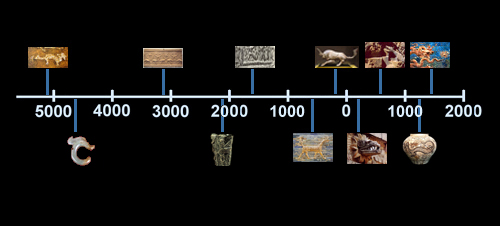
Parallel to these myths, there are also dragons who possess multiple heads. Particularly interesting are the
versions with seven heads. Especially in light of the findings of our previous works based on image analysis
and reconstructions, all depictions and recors are of interest that show aspect of multiple heads.
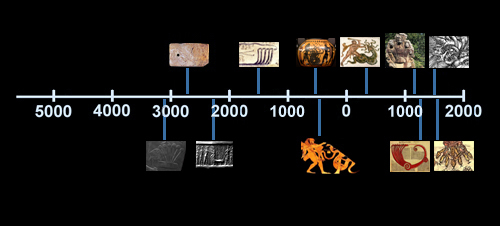
The Dragon from Terby
More than half a year we have puzzled over what kind of animal the geoglyph represents, which is mapped to a rock wall in the
Terby crater . Only now, in the wake of the breakdown of the dragon legends
from around the world, we realize what is represented here. It is also not surprising that there is another "superior"
being standing on that animal.

Click on image to enlarge
The shown image is a new reconstruction of the animal figure based on a higher resolution image template. The end result shows no
striking differents from the older reconstruction. Only the styling is finer and softer now. It was noted in the first analysis
report that this animal figure is a kind of hybrid. The former report was made at a point at which we hitherto knew nothing about
ancient civilizations and the associated creation myths and dragons. The report on artificial structures within the Terby crater
was supposed to show only the presence of geoglyphs, which are in style similar to the geoglyphs in the Nazca plain of Peru.
A connection with the images from Aram Chaos was in no way recognizable. The discovery of the Mars symbol and the
multi-headed dragon monument is an important step to understand the geoglyphs.
The re-examination still show the same characteristic mixing of animal forms and showing it in a
squatting position. Towards the front paws are visible. The mouth is formed very unusual. It could possibly be described as
a beak. Furthermore, it seems to have two long ears or horns. So we want to compare this image with the following one.
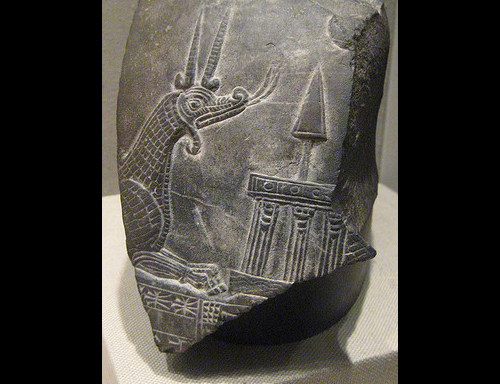
Metropolitan Museum of Art, New York
What we see is a fragment of a Kudurru (landmark) with the depiction of the dragon 'Mushhushshu'. It is the same dragon, which is
also depicted on the famous Ishtar Gate at the Pergamont Museum in Berlin. Mushhushshu is a mythological hybrid creature that
is categorized as a dragon-snake. It has hind legs of an eagle, which are provided with claws, and forelimbs, which
are similar to a lion. Furthermore, it is often depicted with a tail, a horned head and with a snake-like tongue.
Mushhushshu is regarded to be the service animal of the gods Marduk
Marduk and his companion animal Mushhushshu
and Enlil.
A dragon-like creature as a mount of a god is a frequently used icon in our cultural history. In many examples from different
cultures around the world, we can find depictions of deities seating, standing, or lying on mythical animals.
Proportions do not always play a role in such depictions, as we already know it from the geoglyphs in the Terby crater.

To enlarge click on one of the images
The Mythical Figure Atlas - The Reason for the Naming of the Plant
ATLAS - This is the name we discovered above a structure that was identified as the tunnel entrance.
The presence of such lettering on Mars has the consequence that the history of
Space travelling would have to be rewritten, because officially until now no man never has set a foot on Mars.
There is only one nation that provides the needed know-how and also the appropriate
resources to realise such a space project secretly. We're talking of a time period around the year 2000
(or earlier), because the Mars images of Mars Global Surveyor probe derived from 2001. The name ATLAS is at all
not unfamiliar as the Atlas rockets are in use for decades in various models including as
launch vehicle for several satellite systems.
Generally, most people associate Atlas with the figure of a Greek god (or Titan), who carries the Earth on his
shoulders. Against this background, one could assume that the name Atlas was chosen,
in order to underline the importance of this "base". But maybe Atlas was also chosen on the basis of architectural characteristics,
because that facility has a large load-bearing element. However, there might be another plausible explanation why the name was chosen.
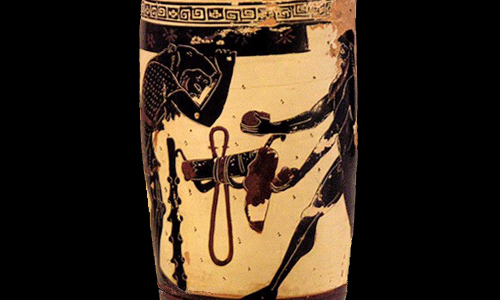
Hercules deputizes Atlas in carrying the sky. Exhibited at National Museum of Archaeology, Athens (520 BC)
The above image example comes from an Attic black-figured Kantharos (drinking vessel). Here, Atlas hands over the golden apples of the Hesperides
to Hercules, who deputized Atlas in carrying the sky. It is often attributed to Hercules, that he killed Ladon, the multi-headed dragon guard,
in order to get free access to the tree with golden apples, but this is only one version of the traditional stories.
No matter which version may be true, it fits beautifully with the surroundings of the plant complex in Aram Chaos, because in the
immediate vicinity of the ATLAS-Base, there is an elevation which was fitted with a huge monument of a multi-headed serpent being.
The Greek mythologies, however, are too young to bring the plants into compliance, e.g., the pre-Sumerian stories about gods and dragons.
But this does not matter, because our research according various dragon myths shows that the original
stories were "passed on" through the ages to other cultures. Certainly, details got lost with the time
or has been altered, but the core of the stories has apparently held up to our time. Atlas is,
for western cultures, yet the most familiar deity, which can be applied to this scenario.
So, it is an indication that probably also a historian or a specialist in archeology belongs to the team of people which are now stationed on Mars.
Atlas is also economically a sensible choice, since the name is short enough to take the effort,
to provide the gateway with meter-high letters.
Therefore, it would be obvious that the surrounding can also be viewed in the context of Greek mythology.
Since there is an elevation with a multi-headed dragon and a mouth-like entrance, that is very close placed to the ATLAS base,
this structure will be called in future reports as the "Ladon Cave".
|
